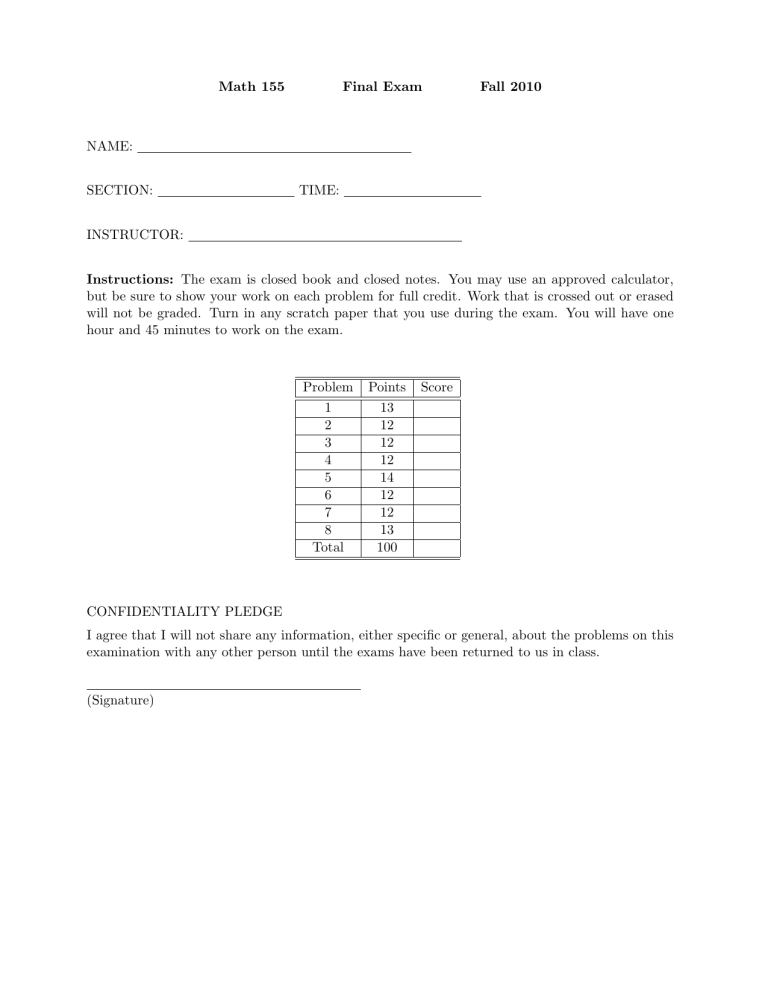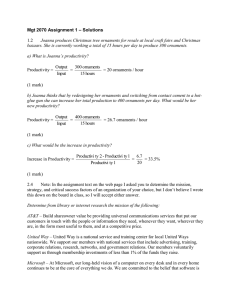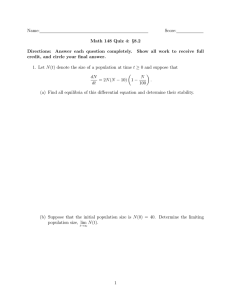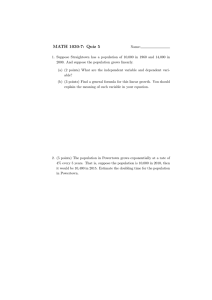Math 155 Final Exam Fall 2010 NAME:

Math 155 Final Exam Fall 2010
NAME:
SECTION: TIME:
INSTRUCTOR:
Instructions: The exam is closed book and closed notes. You may use an approved calculator, but be sure to show your work on each problem for full credit. Work that is crossed out or erased will not be graded. Turn in any scratch paper that you use during the exam. You will have one hour and 45 minutes to work on the exam.
Problem Points Score
7
8
5
6
Total
3
4
1
2
13
12
12
12
14
12
12
13
100
CONFIDENTIALITY PLEDGE
I agree that I will not share any information, either specific or general, about the problems on this examination with any other person until the exams have been returned to us in class.
(Signature)
1. (13 points) Suppose that you have a Christmas tree with 2000 ornaments. After realizing that the tree can’t withstand the weight of so many ornaments, you decide to remove some ornaments from the tree. Suppose that every day you take off ornaments so that 91% of the ornaments remain from the previous day.
(a) Let x t
= the number of ornaments on your tree on day t .
Write down a discretetime dynamical system, together with an initial condition, that describes the situation described above.
(b) Find the solution to the discrete-time dynamical system and initial condition from (a).
(c) You decide that a reasonable number of ornaments for the tree is 250. How many days will it take for the tree to have this many ornaments if you continue taking them off in the above process? (That is, what time t will the number of ornaments equal 250?)
2
2. (12 points) Suppose that the population p t of platypi satisfies the discrete-time dynamical system p t +1
= (4 − p t
) p t
− hp t
, where h > 0 is a positive parameter, and p t is measured in hundreds of platypi.
(a) Find all equilibria. For what values of h is there more than one equilibrium that makes biological sense?
(b) For each equilibrium, use the Stability Theorem/Criterion to determine the values of h for which that equilibrium is stable. Show clearly how you are using the Stability
Theorem/Criterion.
3
3. (12 pts)
(a) Find the leading behavior at infinity and zero for ax 2 + ln( x ) f ( x ) = be 2 x + cx 10 + dx 1 / 2 where a, b, c, d are all positive constants.
f
∞
= f
0
=
(b) Evaluate the following limits. Show all of your work. If you use Leading Behavior, justify your answer by explaining all of your steps. If you use L’Hopital’s Rule, justify why it can be applied each time you use it.
i. lim x → π cos( x ) + 1 sin( x ) ii. lim t → 0 te t ln(
− t
10 t
+ 1)
2
4
4. (12 points) Having decided that socks directly translate into profit, the sock gnomes are attempting to steal as many socks as possible from unsuspecting children this holiday season.
Because it takes time to rummage through drawers and dirty clothes hampers, the number of socks collected per house is a function of time (measured in minutes) given as
8 t
U ( t ) =
1 + t
Taking into account how long it takes to travel between houses, the rate at which socks are collected is given by
U ( t )
R ( t ) = t + 3
=
8 t
(1 + t )( t + 3)
.
(a) Since a gnome could get caught after 4 minutes in the same house, find the time that the gnomes should spend at each house to maximize the rate at which socks are collected on the time interval [0 , 4]. (b) Verify that you have found a local maximum by using either the first or second derivative test. (c) Report the global maximum of R ( t ) on the interval [0 , 4].
5
5. (14 points)
(a) Evaluate the following definite and indefinite integrals. If necessary, use substitution.
Show all of your work.
i.
R
2
1
( t
2
+ t )d t ii.
R x
1+ x 2 d x
(b) Evaluate the following integral using Integration By Parts:
R
( x
2 ln x )d x
(c) Find the average value of the function sin( x ) cos( x ) on the interval [0 ,
π
2
].
6
6. (12 pts) By way of the East Road, a hobbit travels between Hobbiton and Bree. Let X ( t ) = the hobbit’s distance (in km) from Bree at time t (in days). Suppose that dX
= 25 + 3 t cos( t
2
) .
dt
(a) Write out (but do not evaluate/solve) a definite integral that represents the total distance the hobbit travels between times t = 1 and t = 2.
(b) Determine X ( t ) if X (0) = 100. (That is, find a solution to the differential equation dX dt
= 25 + 3 t cos( t
2
) with initial condition X (0) = 100.)
7
7. (12 points) As Lucy Westenra gets progressively more pallid and ill, Mina Murray adds more and more garlic to Lucy’s bedside (at the urging of Professor Van Helsing). Suppose that the initial amount of garlic at t = 0 is 10 cloves, and the number increases at a rate of e
0 .
5 t cloves per hour.
(a) Let G ( t ) represent the number of garlic cloves at time t . Write a pure-time differential equation and an initial condition for the scenario described above.
(b) Apply Euler’s Method with ∆ t = 2 to approximate the number of garlic cloves at time t = 6. Show your work clearly with a table. Round your final answer up to the next whole number, and write your units. Recall the formula:
G next
G current
+ dG
∆ t dt
8
8. (13 points)
(a) A colony of bacteria in a vat is producing a pharmaceutical chemical. Let c ( t ) be the concentration (in mol/L) of the chemical in the vat at time t . Suppose that dc
= dt
10 t
1 + 4 t mol/L per hour .
i) Use a left-hand Riemann sum with ∆ t = 0 .
5 to calculate an estimate for the total change in c ( t ) between times t = 0 .
5 and t = 2. ii) Draw the rectangles or step functions corresponding to your calculation on the figure below.
(b) Use a tangent-line approximation of the function f ( x ) =
√ x to approximate your answer to three decimal places.
√
9 .
1. Give
9




